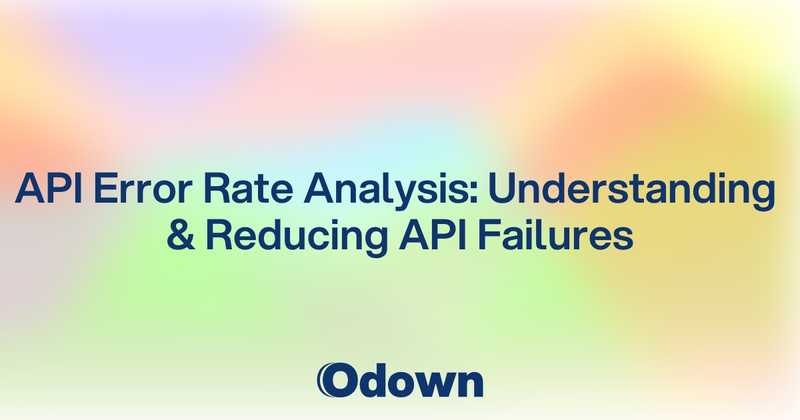API Error Rate Analysis: Understanding and Reducing API Failures
Your API just threw a 500 error for the third time this hour. Your mobile app is crashing. Your customers are complaining on Twitter. And you have no idea what's causing it because you're not tracking API errors properly.
This scenario plays out daily at companies worldwide. APIs have become the backbone of modern applications, but most teams treat API monitoring as an afterthought. They monitor server uptime and response times but ignore the error rates that actually indicate whether their APIs work correctly.
API error rate analysis isn't just about counting failures - it's about understanding why they happen and preventing them from ruining your users' experience. When you get this right, you catch problems before customers notice them and fix root causes instead of just symptoms.
Why API Error Rates Matter More Than You Think
APIs fail in ways that basic uptime monitoring completely misses. Your server can be responding perfectly to health checks while your actual API endpoints are throwing errors left and right.
I've seen this happen repeatedly. A team proudly shows me their 99.9% uptime dashboard while their error logs are full of 400 and 500 status codes. Their monitoring says everything is fine, but their users are getting broken responses to every API call.
The problem is that many teams conflate server availability with API functionality. Just because your server responds doesn't mean your API is working. Authentication might be broken, database connections might be failing, or third-party integrations might be timing out. Users don't care that your server is "up" if they can't actually use your application.
The Hidden Cost of API Errors
API errors cost more than just immediate user frustration. Each failed request represents a user who couldn't complete their intended action. In e-commerce, that's lost revenue. In SaaS applications, that's frustrated customers who might churn to competitors.
The ripple effects compound quickly. Failed API calls often trigger retry logic in client applications, multiplying the load on your servers. This can turn a small issue into a cascading failure that brings down your entire system.
API errors also create support burden. Users don't understand HTTP status codes - they just know "the app isn't working." Your support team fields tickets about vague problems while your engineering team struggles to correlate user complaints with technical issues.
Different Types of API Failures
Not all API errors are created equal. Understanding the different categories helps you prioritize fixes and build better monitoring.
Client Errors (4xx) usually indicate problems with how your API is being called. Authentication failures, malformed requests, and rate limiting fall into this category. While technically not your API's fault, high rates of client errors often indicate poor API design or inadequate documentation.
Server Errors (5xx) represent actual problems with your API infrastructure. Database connection failures, timeouts, and unhandled exceptions all generate server errors. These should be your highest priority since they indicate issues entirely within your control.
Timeout Errors happen when requests take too long to complete. These often get overlooked because they don't generate traditional HTTP error codes, but they're just as frustrating for users as explicit failures.
Rate Limiting Errors occur when clients exceed API usage limits. While necessary for protecting your infrastructure, high rates of limiting errors might indicate that your limits are too restrictive or that clients aren't implementing proper backoff strategies.
Setting Up Comprehensive API Error Monitoring
Effective API error monitoring goes beyond just counting HTTP status codes. You need to track errors in context, understand their business impact, and correlate them with other system metrics.
Track Errors by Endpoint
Different API endpoints have different error patterns and business criticality. Your user authentication endpoint should have near-zero errors, while experimental features might tolerate higher error rates during development.
Set up monitoring that tracks error rates per endpoint, not just aggregate error rates across your entire API. This granular view helps you identify problematic endpoints quickly and prioritize fixes based on business impact.
Group endpoints logically when it makes sense. All user management endpoints might share similar error patterns, while payment processing endpoints require different monitoring approaches.
Monitor Error Rates Over Time
Error rate trends often reveal more than absolute numbers. A gradually increasing error rate might indicate a slow memory leak or degrading database performance. Sudden spikes usually point to deployment issues or external service failures.
Track error rates at multiple time intervals - minute-by-minute for incident response, hourly for trend analysis, and daily for capacity planning. Different time windows reveal different types of problems.
Seasonal patterns matter too. E-commerce APIs might show higher error rates during holiday traffic spikes, while business APIs might see patterns that correlate with work schedules.
Categorize Errors by Root Cause
HTTP status codes tell you what failed, but not why it failed. Build monitoring that categorizes errors by underlying cause: database issues, network problems, third-party service failures, or application bugs.
This categorization helps you understand whether errors stem from infrastructure problems you can fix or external dependencies you need to work around. It also helps you build better alerting - database connection errors need immediate attention, while third-party service timeouts might just need retry logic.
Use structured logging to capture error context. Include request IDs, user information, and relevant business data that helps you understand the impact of each error.
Set Meaningful Thresholds
Alert thresholds for API errors need to balance sensitivity with practicality. Alert too aggressively and you'll get paged for every minor blip. Set thresholds too high and you'll miss significant problems.
Start with baseline measurements during normal operation. What's your typical error rate for each endpoint? What's the normal variation throughout the day? Use this data to set thresholds that account for expected fluctuations.
Consider both absolute error counts and error percentages. A single endpoint generating 100 errors per minute is concerning regardless of traffic volume. But 100 errors out of 100,000 requests might be acceptable, while 100 errors out of 1,000 requests definitely isn't.
Analyzing API Error Patterns
Raw error counts don't tell you much. The real insights come from analyzing error patterns to understand what's actually going wrong and how to fix it.
Look for Correlation Patterns
API errors rarely happen in isolation. Database connection errors might correlate with memory usage spikes. Authentication failures might cluster around deployment times. Third-party service errors might follow their maintenance schedules.
Build dashboards that show API error rates alongside infrastructure metrics, deployment events, and external service status. These correlations help you identify root causes faster and prevent similar issues in the future.
Pay attention to error clustering. If errors happen randomly, you might have an intermittent infrastructure issue. If they cluster around specific times or user actions, you probably have a logic bug or resource contention problem.
Analyze Error Distribution
How errors distribute across your user base reveals important patterns. Are errors affecting all users equally, or are they concentrated among specific user segments?
High-value customers experiencing disproportionate error rates might indicate capacity issues during peak usage. New users seeing more errors might suggest onboarding flow problems. Geographic clustering of errors could point to regional infrastructure issues.
User agent analysis helps too. If mobile clients see higher error rates than web clients, you might have mobile-specific integration issues. If specific API client versions correlate with higher error rates, you might need to deprecate buggy client code.
Track Business Impact
Technical metrics are important, but business impact metrics matter more. How do API errors affect user conversion rates, revenue, and customer satisfaction?
Connect API error data to business metrics wherever possible. Track how authentication errors affect user signup rates, how payment API errors affect transaction completion, and how search API errors affect user engagement.
This business context helps you prioritize fixes and communicate the impact of API reliability work to stakeholders who don't care about HTTP status codes but definitely care about revenue and customer experience.
Common API Error Patterns and Solutions
Certain API error patterns appear repeatedly across different applications and industries. Understanding these common patterns helps you diagnose and fix problems faster.
Authentication and Authorization Failures
Authentication errors often spike after deployments, indicating configuration issues or token validation problems. They also increase gradually over time if token refresh logic isn't working properly.
These errors have high business impact since they prevent users from accessing your application at all. Monitor authentication error rates separately from other API errors and alert aggressively on increases.
Common causes include expired certificates, misconfigured authentication services, clock skew between servers, and database connection issues affecting user lookup. Most are infrastructure problems that require immediate attention.
Database Connection and Query Errors
Database-related API errors often follow predictable patterns. Connection pool exhaustion causes periodic spikes of errors followed by recovery periods. Slow queries cause timeout errors that correlate with database performance metrics.
These errors usually indicate capacity or configuration issues. Monitor database connection pool metrics alongside API error rates to identify when you're approaching limits.
Query timeout errors might indicate missing database indexes, inefficient queries, or database server performance problems. Correlate API timeout errors with database query performance logs to identify problematic queries.
Third-Party Service Integration Failures
APIs that depend on external services inherit the reliability characteristics of those services. Payment processors, social media APIs, and cloud services all have their own outage patterns that affect your API error rates.
Build monitoring that distinguishes between errors caused by your code and errors caused by external dependencies. This helps you communicate accurately with users and focus engineering effort appropriately.
Implement circuit breaker patterns for external service calls and monitor circuit breaker state alongside error rates. This helps you understand when degraded external services are affecting your API performance.
Rate Limiting and Capacity Issues
Rate limiting errors often indicate either legitimate traffic spikes that exceed your capacity planning or abuse patterns that need attention.
Monitor rate limiting errors alongside traffic volume and user behavior metrics. Sudden spikes might indicate viral content or marketing campaign traffic. Gradual increases might suggest growing user base or changing usage patterns.
Distributed denial of service attacks often show up as patterns of rate limiting errors from many different IP addresses. Geographic distribution of rate limiting errors helps identify potential abuse.
Building Better APIs Through Error Analysis
API error analysis isn't just about fixing problems - it's about building better APIs that fail less often and handle failures more gracefully.
Design for Failure
The best APIs assume that failures will happen and handle them gracefully. This means returning meaningful error messages, implementing proper retry logic, and degrading functionality smoothly when dependencies fail.
Use error analysis data to identify which failures happen most often and design better handling for those scenarios. If third-party service timeouts are common, implement fallback behavior that keeps your API functional even when dependencies are slow.
Error message quality matters too. Analyze which error responses lead to the most support tickets and improve the error messages to help users and developers understand what went wrong.
Implement Progressive Reliability
Not all API endpoints need the same level of reliability. Critical user authentication and payment processing endpoints should have near-zero error tolerance. Experimental features and non-critical functionality can tolerate higher error rates.
Use error analysis to establish different reliability targets for different parts of your API. This helps you allocate engineering effort effectively and set appropriate user expectations.
Build monitoring and alerting that reflects these different reliability requirements. Page the on-call engineer for payment API errors, but just log errors from experimental features for review during business hours.
Learn from Error Patterns
Error analysis reveals opportunities for architectural improvements. If certain endpoints consistently show higher error rates, they might need different infrastructure approaches or better resource allocation.
Seasonal error patterns help with capacity planning. If errors spike during traffic increases, you might need better auto-scaling or larger baseline capacity. If errors correlate with specific user behaviors, you might need to optimize those code paths.
Use error data to inform API versioning decisions too. If older API versions show significantly higher error rates, it might be time to deprecate them and migrate users to more reliable newer versions.
Good API error analysis turns debugging from reactive firefighting into proactive system improvement. You catch problems before they affect users, understand root causes instead of just symptoms, and build more reliable systems over time.
Ready to get serious about API reliability? Odown provides comprehensive API monitoring that tracks error rates, response times, and failure patterns across all your endpoints. Combined with our monitoring automation tools and uptime monitoring strategies, you'll have complete visibility into your API health and the tools to keep everything running smoothly.



